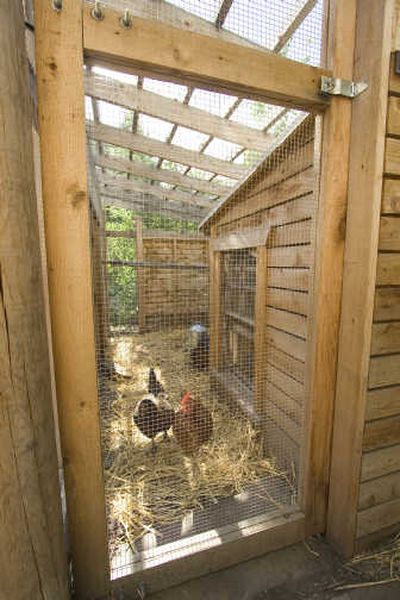Quality coop becomes chicken coup

A successful Spokane architect who specializes in residential design, Thomas Angell seems an unlikely candidate for engineering a chicken coop.
“I did a lot of research,” Angell says of the sleek, modern-looking structure occupying one corner of his family’s front yard near Whittier Park west of downtown.
Inside the cedar plank and log structure, several chickens strut about their stylish abode, enjoying the shade it provides from the hot July sun. In addition to shielding his hens from heat and cold, Angell says one of the biggest challenges in designing an urban coop is protecting the birds from predators – coyotes, raccoons and skunks that frequent suburban and sometimes urban parts of town.
“It continues to be a learning process,” he says, though one that his family feels is well worth the effort. “We do it for the eggs – there’s just no comparison.”
And Angell is not alone.
His coop is one of six to be featured on an upcoming tour of inner-city chicken coops in Spokane. Sponsored by the Slow Food Spokane River Convivium, the first annual Urban Chicken Coop Tour will give participants a glimpse at what it’s like to raise chickens in the city.
Tour organizer Kim Burkland says she hopes the July 21 event will be a fun way to make raising chickens more accessible to Spokane residents.
“I used to live in Portland, and there’s a coop tour there, so when we moved out here we knew we wanted to have a coop,” she says of her own backyard hen habitat.
Burkland says it is illegal to own roosters in the city, but individuals can own up to three hens, subject to setback regulations.
Like Angell, Burkland says predators are one of the biggest challenges to raising chickens in the city.
“They’re almost your pets, so sometimes it might be harder to lose your chicken to a predator,” she says. “You see them more often, they’re more of a personality maybe than if you had 25 to 100 chickens.”
Beyond that, the needs of urban and country hens are surprisingly similar. Food, water and shelter are among the fundamental elements involved in owning chickens, Burkland says, adding that the tour will address these and other topics.
One coop will focus on deterring predators while another will address nesting boxes for egg laying. One will raise the issue of chickens as pets, while a fourth will focus on chickens and garden composting.
“And at Angell’s we’ll talk about coop design and construction,” Burkland says, adding that a feast of fresh egg dishes prepared by Slow Food members will be available following the tour, which is expected to last at least three hours.
Burkland says she hopes the tour, in conjunction with Slow Food, will provide networking and support to urban chicken owners.
“It’s an opportunity to showcase the local, seasonal eating and growing that we’re all talking about,” she says, adding that she hopes to make the chicken coop tour an annual event.